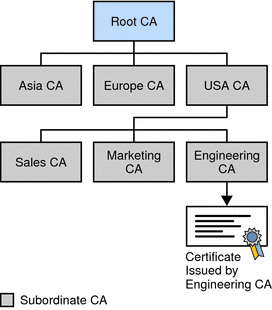I came across a really good document from Oracle on certificates and security related topic. Below is the link -
https://docs.oracle.com/cd/E19656-01/821-1507/gdzeb/index.html
Pasting here some of the contents in case the url changes or goes away.
Certificates - A certificate is an electronic document that identifies an individual, a server, a company, or some other entity. A certificate also associates that identity with a public key. Like a driver’s license, a passport, or other commonly used personal IDs, a certificate provides generally recognized proof of someone's or something's identity.
Certificate Authority (CA) - Certificate authorities, CAs, validate identities and issue certificates. CAs can be independent third parties or organizations that run their own certificate-issuing server software. The methods used to validate an identity vary depending on the policies of a given CA. In general, before issuing a certificate, the CA must use its published verification procedures for that type of certificate to ensure that an entity requesting a certificate is in fact who it claims to be.
Any client or server software (like browser) that supports certificates maintains a collection of trusted CA certificates. These CA certificates determine which other certificates the software can validate, in other words, which issuers of certificates the software can trust. In the simplest case, the software can validate only certificates issued by one of the CAs for which it has a certificate. It’s also possible for a trusted CA certificate to be part of a chain of CA certificates, each issued by the CA above it in a certificate hierarchy.
CA Hierarchy - In large organizations, it may be appropriate to delegate the responsibility for issuing certificates to several different certificate authorities. For example, the number of certificates required may be too large for a single CA to maintain; different organizational units may have different policy requirements; or it may be important for a CA to be physically located in the same geographic area as the people to whom it is issuing certificates.
Certificate Chains -
A certificate chain traces a path of certificates from a branch in the hierarchy to the root of the hierarchy. In a certificate chain, the following occur:
Certificates - A certificate is an electronic document that identifies an individual, a server, a company, or some other entity. A certificate also associates that identity with a public key. Like a driver’s license, a passport, or other commonly used personal IDs, a certificate provides generally recognized proof of someone's or something's identity.
Certificate Authority (CA) - Certificate authorities, CAs, validate identities and issue certificates. CAs can be independent third parties or organizations that run their own certificate-issuing server software. The methods used to validate an identity vary depending on the policies of a given CA. In general, before issuing a certificate, the CA must use its published verification procedures for that type of certificate to ensure that an entity requesting a certificate is in fact who it claims to be.
Any client or server software (like browser) that supports certificates maintains a collection of trusted CA certificates. These CA certificates determine which other certificates the software can validate, in other words, which issuers of certificates the software can trust. In the simplest case, the software can validate only certificates issued by one of the CAs for which it has a certificate. It’s also possible for a trusted CA certificate to be part of a chain of CA certificates, each issued by the CA above it in a certificate hierarchy.
CA Hierarchy - In large organizations, it may be appropriate to delegate the responsibility for issuing certificates to several different certificate authorities. For example, the number of certificates required may be too large for a single CA to maintain; different organizational units may have different policy requirements; or it may be important for a CA to be physically located in the same geographic area as the people to whom it is issuing certificates.
Certificate Chains -
A certificate chain traces a path of certificates from a branch in the hierarchy to the root of the hierarchy. In a certificate chain, the following occur:
- Each certificate is followed by the certificate of its issuer.
- The Engineering CA certificate contains the DN of the CA (that is, USA CA), that issued that certificate. USA CA’s DN is also the subject name of the next certificate in the chain.
- Each certificate is signed with the private key of its issuer. The signature can be verified with the public key in the issuer’s certificate, which is the next certificate in the chain.

No comments:
Post a Comment